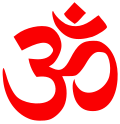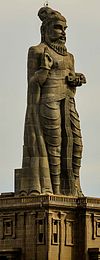Sivaya Subramuniyaswami
Sivaya Subramuniyaswami | |
|---|---|
Nath (Nandinatha Sampradaya) | |
| Initiation | 1949 Jaffna, Ceylon by Jnanaguru Yogaswami |
| Religious career | |
| Guru | Jnanaguru Yogaswami |
| Predecessor | Jnanaguru Yogaswami |
| Successor | Bodhinatha Veylanswami |
| Initiated | Sannyasa |
| Part of a series on | |
| Hindu philosophy | |
|---|---|
 | |
| Orthodox | |
|
|
|
| Heterodox | |
|
|
|
Sivaya Subramuniyaswami (born Robert Hansen; January 5, 1927 – November 12, 2001) was an American Hindu religious leader known as Gurudeva by his followers. Subramuniyaswami was born in Oakland, California and adopted Hinduism as a young man. He was the 162nd head of the self claimed Nandinatha Sampradaya's Kailasa Parampara and Guru at Kauai's Hindu Monastery which is a 382-acre (155 ha) temple-monastery complex on Hawaii's Garden Island.[1]
In 1947, at the age of 20, he journeyed to
He is part of the guru
His influence reflected the reach of his publications, including the approximately 30 books he wrote. Subramuniyaswami was described by Klaus Klostermaier as "the single-most advocate of Hinduism outside India".[7] The book Religious Leaders of America explained Subramuniyaswami's role as "a pillar of orthodox Hinduism."[8]
Biography
Youth in California (1927–1946)
Sivaya Subramuniyaswami was born in
Sivaya Subramuniyaswami's training in classical Eastern and Western dance and in the disciplines of
Visit to Sri Lanka (1947–1949)
Sivaya Subramuniyaswami spent almost three years on the island of
In the caves of Jalani, Kurugala Balandha, Sri Lanka, he fasted and meditated until he experienced what he felt to be enlightenment. Sivaya Subramuniyaswami relates his feelings while returning to Colombo, Sri Lanka: "Returning back to the city, nothing looked the same anymore. I was in another dimension. Everything was different. I had lost something: the desire for the realization of the Self. I felt complete. I felt alone."[10]

Back in Colombo, Sivaya Subramuniyaswami met his final teacher before meeting his guru. One day, his teacher arranged a meeting between Sivaya Subramuniyaswami and his long-awaited
Yogaswami continued to communicate with Sivaya Subramuniyaswami through Kandiah Chettiar until his death in 1964. In the line of successorship, Subramuniya was considered the 162nd Jagadacharya of the Nandinatha Sampradaya's Kailasa Parampara.
San Francisco (1949–1970)
In late 1949 Subramuniya sailed back to America and embarked on seven years of ardent, solitary yoga and meditation In 1956, Sivaya Subramuniyaswami said, he had a tremendous spiritual experience in Denver, Colorado, where "the soul body would finally fully inhabit the physical body".[10][13] The following year, in San Francisco, Subramuniya founded what is now Himalayan Academy and opened America's first Hindu temple at 3575 Sacramento Street, near Presidio Park. In Switzerland, 1968, he wrote of Shum, a mystical language of meditation that names and maps inner areas of consciousness.
Subramuniya in the 1950s and 1960s
The biographies of Subramuniya show a time of transition between 1950 and 1957. Subramuniya states that he was ordered not to teach until he turned thirty in January 1957. He spent some of these seven years traveling around the United States, teaching hatha yoga classes and exploring various non-traditional religions, such as Christian Science, Theosophy, and the science of the mind, the closest Western religions to Hindu thought.[14] His shift to a teaching ministry as Master Subramuniya in 1957 blends elements of these religious movements with Hindu yogic and Vedanta teachings in a language oriented toward his followers at the time, who were Westerners.[15] Subramuniya in the 1950s and 1960s might be placed in an American metaphysical lineage that can be traced from 19th century Theosophy to the New Age Movement in the late 1970s.
Accordingly, Subramuniya's early publications, The Self-God (1959), Cognizantibility (1958), Gems of Cognition (1958) and Clear White Light (1968) do not mention Saiva Siddhanta, Hinduism, Shiva, his guru or lineage or his avocation of temple worship so prominently found in his later works. All of Subramuniya's early works stress meditation, an advaita based monism and yoga.
Subramuniya also experimented with combining aspects of Hinduism with Christianity in another context. He opened two centers in San Francisco in 1957: one Hindu, the Subramuniya Yoga Order, and the other a Hindu/Christian hybrid, the Christian Yoga Church.[16] A typical Sunday worship at the Christian Yoga Church included the singing of Christian hymns, readings from the New Testament and the Bhagavad Gita or Upanishads and a sermon related to Christian or Hindu mysticism. In this context, Master Subramuniya was known as Father Subramuniya.[17]
Kauai (1970–2001)
Sivaya Subramuniyaswami moved his ashram to Kauai in 1970, establishing Kauai Aadheenam, on a riverbank near the foot of an extinct volcano. Also known as Kauai's Hindu Monastery, Kauai Aadheenam is a 382-acre (155 ha) temple-monastery complex on Hawaii's Garden Island. In 1979 he published the Holy Orders of Sannyas, defining the ideals, vows and aspirations of Hindu

In 1986 Sivaya Subramuniyaswami founded a
Death
Learning on October 9, 2001, that he had advanced, metastasized intestinal cancer, confirmed by a host of specialists in three states, all concurring that even the most aggressive treatment regimens would not prove effective, he declined any treatment beyond palliative measures and decided to follow the Indian yogic practice, known as
Spiritual lineage
He followed the shaivism sect (Shaiva Siddhanta) of Hinduism. He belongs to Nandinatha Sampradaya's Kailasa Parampara. Saiva siddhanta is prevalent in South India, Sri Lanka and Malaysia.[20][21]
Spiritual lineage : Maharishi Nandinath → Sundaranandar, Siddhar who later becomes Tirumular → → → Kadaitswami → Chellapaswami → Siva Yogaswami → Sivaya Subramuniyaswami → Bodhinatha Veylanswami[22]
Honors and awards

- 1986 - New Delhi's Parliament of the World's Religions named Sivaya Subramuniyaswami one of five modern-day Jagadacharyas, means world teachers, for his international efforts in promoting Hinduism.[8][23]
- 1988 - Oxford, England: Hindu representative at the Global Forum of Spiritual and Parliamentary Leaders for Human Survival. Sivaya Subramuniyaswami joined hundreds of religious, political and scientific leaders from all countries to discuss privately, for the first time, the future of human life on this planet.
- 1988 - Oxford : he represented Hinduism at the Global Forum of Spiritual and Parliamentary Leaders .[8]
- 1990 - Moscow : he again represented Hinduism at the Global Forum of Spiritual and Parliamentary Leaders
- 1992 - Rio de Janeiro : he again represented Hinduism at the Global Forum of Spiritual and Parliamentary Leaders
- 1993 - Swami Chidananda Saraswati of the Rishikesh-based Divine Life Society and Kerala's Mata Amritanandamayi, to represent Hinduism at the Presidents' Assembly, a core group of 25 men and women voicing the needs of world faiths.
- 1995 - New Delhi's Parliament of the World's Religions bestowed on Sivaya Subramuniyaswami the title Dharmachakra for his remarkable publications.
- 1997 - Sivaya Subramuniyaswami responded to the US President's call for religious opinions on the ethics of cloning from the Hindu point of view.
- 1997 - Sivaya Subramuniyaswami spearheaded the 125th anniversary of Satguru Yogaswami and his golden icon's diaspora pilgrimage through many of the over 75 Sri Lanka temples and societies around the globe.
- 2000 - On August 25, he received the U Thant Peace Award (an award created by Sri Chinmoy) at the United Nations in New York. Prior recipients of this award were the Dalai Lama, Nelson Mandela, Mikhail Gorbachev, Pope John Paul II and Mother Teresa. He addressed 1,200 spiritual leaders gathered for the UN Millennium Peace Summit, with the message, “For peace in the world, stop the war in the home.”
Books
Gurudeva was author of more than 30 books offering insights on Hindu
His Master Course[25] is Sivaya Subramuniyaswami's comprehensive treatise on Shaivism in three books and more than 3,000 pages, composed in what he called "talkanese" - a flowing version of written English that resembles the spoken language and evokes ancient Hindu oral traditions. His Master Course includes three books :
- Dancing with Siva
- Living with Siva
- Merging with Siva
Some of his other books:
- Yoga's Forgotten Foundation
- Loving Ganesha
- How to Become a Hindu: A Guide for Seekers and Born Hindus
- Tirukkural: The American English and Modern Tamil Translations of an Ethical Masterpiece
- Holy Orders of Sannyas: A Saiva Swami's Diksha and Lifetime Vows of Renunciation
- Weaver's Wisdom: Ancient Precepts for a Perfect Life
- Pancha Ganapati: An alternative for Christmas
Four areas of service
The four areas of service established by Sivaya Subramuniyaswami and now carried out by his successor,
Saiva Siddhanta Church
The mission of the Church is to preserve and promote the
Hindu Heritage Endowment
Hindu Heritage Endowment is a public service trust founded by Sivaya Subramuniyaswami in 1995.
Hinduism Today
Hinduism Today is an international quarterly magazine founded by Sivaya Subramuniyaswami in 1979. It is a public service of his monastic order, created to strengthen all Hindu traditions by uplifting and informing followers of the Hinduism everywhere.[11]
See also
References
- ^ "Satguru Sivaya Subramuniyaswami". Himalayanacademy. (Source closely affiliated with the subject)
- ISBN 978-1-934145-39-5. Archived from the original on December 6, 2019. (Source closely affiliated with the subject)
- ^ Dr. Vimala Krishnapillai (April 1, 2004). "Siva Yogaswami, the Sage and mystic of Sri Lanka". Daily News (Sri Lanka). Retrieved January 16, 2013.
- ^ Rudolph, Ephraim (December 7, 2015). "3 International December Holidays You May Not Know About". Indianapolis, Indiana: The International Center (INTLCTR). Archived from the original on December 8, 2015.
- ^ "Pancha Ganapati:The Family Festival of Giving". Hinduism Today. Himalayan Academy. 2010. Archived from the original on November 28, 2012. (Source closely affiliated with the subject)
- ^ "Lineage". Himalayanacademy. (Source closely affiliated with the subject)
- ISBN 9780791470824.
Sivaya Subramuniyaswami ... did much to propagate a kind of reformed Saivism through his books. As founder-editor of Hinduism Today, an illustrated monthly, he became the single-most advocate of Hinduism outside India.
- ^ a b c d Douglas Martin (November 19, 2001). "Satguru Subramuniyaswami, Hindu Spiritual Leader, 74". The New York Times. Retrieved January 8, 2013.
- ^ "Himalayan Academy Publications - the Guru Chronicles".
- ^ a b c "The Making of a Master". Hinduism Today. No. April/May/June. Himalayan Academy. 2002.
- ^ .
- ISBN 0-945497-95-4, page 909
- ^ "The Making of a Master". Hinduism Today. April 1, 2020. Retrieved September 23, 2021.
- ISBN 978-1-4384-4791-9.
- ISBN 978-0-253-33612-5.
- ISBN 978-0-8126-9310-2.
- ^ Lucas 1995, p. 13
- ^ "Kauai's Hindu Monastery". Kauai's Hindu Monastery.
- ^ "Our Spiritual Lineage, the Kailasa Parampara".
- ^ External reviews of Dancing with Siva (Source closely affiliated with the subject)

